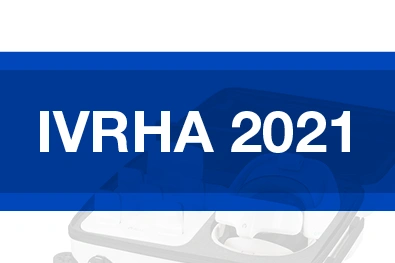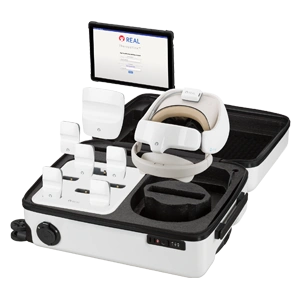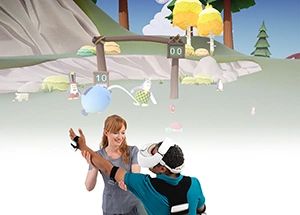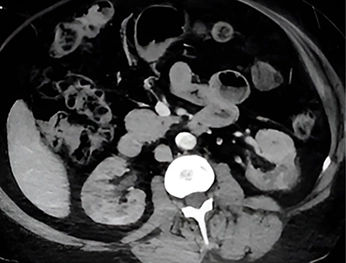Meetings & Events: Penumbra Announces Participation at IVRHA’s Annual Symposium

REAL® Immersive System VR Platform for Healthcare Subject of Keynote at 5th Annual Virtual Reality and Healthcare Global Symposium
Penumbra, Inc. is pleased to announce its participation at the 5th Annual Virtual Reality and Healthcare Global Symposium, a virtual conference to be held March 2-5. Organized by the International Virtual Reality and Healthcare Association (IVRHA), the annual meeting is attended by a mix of virtual reality (VR) experts, academics, healthcare professionals, and members of the VR tech industry, among others. According to its mission statement, IVRHA’s goal is to facilitate and support the growth of the virtual reality and healthcare simulation industries as this new computing platform impacts healthcare practitioners and patients around the world.
Over the course of two days, Penumbra executives will sit down with Dr. Walter Greenleaf, Behavioral Neuroscientist and medical technology developer from Stanford University’s Virtual Human Interaction Lab, to discuss the company’s VR tech journey, product design to patient use cases, as well as the future of rehabilitation with VR. Considered a leading authority, Dr. Greenleaf has over three decades of research and development experience in the field of digital medicine and medical VR technology.
During their respective sessions, Penumbra CEO Adam Elsesser and EVP & REAL® System GM Gita Barry will discuss Penumbra’s REAL Immersive System, a purpose-built VR platform for healthcare applications. The REAL System is designed to give clinicians the ability to customize individual rehabilitation sessions based on each patient’s therapeutic goals, while offering patients fun, engaging therapeutic exercises developed with extensive input from rehabilitation experts to support motor learning and cognitive function.
Penumbra Speaker Events
- Keynote | Fireside Chat: Penumbra CEO Adam Elsesser in conversation with Dr. Walter Greenleaf
Tuesday, March 2, 1:00 p.m. (EST) | 10:00 a.m. (PST)
- Fireside Chat: Penumbra EVP & REAL GM Gita Barry in conversation with Dr. Walter Greenleaf
Wednesday, March 3, 11:00 a.m. (EST) | 8:00 a.m. (PST)
To access the symposium’s full schedule, visit https://health21.ivrha.org.
The Research on Virtual Reality and Rehabilitation
Virtual Reality (VR) has the potential to engage patients in rehabilitation effectively, which, in turn, can motivate them to follow their prescribed course of therapy.1,2 VR transports users to a virtual world, allowing individuals to view their bodies as virtual images (avatars) engaged in activities often not feasible in the actual world.2 VR has been shown to induce neuroplasticity, improve range of motion, and enhance cognitive skills.1,2
As one example with VR technology, the affected side of a patient’s avatar can be programmed to mirror the actions of the unimpaired side during bi-lateral (two-sided) movement.1 During a VR therapy session, a patient with an affected left arm might view that arm function similarly to the unaffected arm. The brain is then triggered to create new neural pathways upon observing both arms functioning normally in the virtual world.1
The virtual world itself can be programmed with functional and engaging games that help patients relearn activities of daily living, as well as offer reward-driven cognitive puzzles. The motor tasks and cognitive puzzles can be adjusted to support each patient’s recovery state so that their complexity increases in step with individual progress.1,2
Benefits of virtual reality can include:
- A full presence, virtual avatar that mirrors every move in real time. This helps the patient’s brain accept the avatar as the patient’s actual body.1,2
- Employment of popular video game elements such as variability, rewards, and progress tracking. This helps maximize patient enjoyment and engagement.2
- A rehabilitation environment that patients perceive as encouraging, and efficient1
- Activities tailored to each patient’s individual needs
- Documentation of session-to-session progress2
About the REAL Immersive System
The REAL System is an advanced rehabilitation technology using VR to help patients reach their full potential. The REAL System has multiple therapeutic activities built with extensive input from rehabilitation experts designed to support motor learning and cognitive function. The system transports patients to a fully immersive virtual world where mundane repetitive exercises are replaced by therapeutic activities that offer endless possibilities, like placing birds into nests to support postural control.
REAL Activities cover a range of therapeutic areas including:
- Proximal and Distal Upper Extremity (UE)
- Core, Cervical Range of Motion (ROM) and Balance
- Cognition
- Functional uses with preparation for Activities of Daily Living (ADLs)
For clinicians, adjustable settings provide the ability to customize sessions and continually challenge patients. Rewards-based feedback and objective progress tracking motivate and inform patients of progress. Comprised of REAL Activities, proprietary TherapyView™ software, sensors, headset, and a tablet, the REAL System provides a powerful platform to make engaging therapeutic experiences possible.

The REAL System
The REAL System is self-contained in a portable case, with no external infrastructure required. It comprises TherapyView on a tablet used by the therapist to administer and monitor patient sessions as well as 6 body sensors and headset worn by the patient.

During setup, the patient is immediately immersed in REAL Activities to practice familiar therapeutic motions, like shoulder flexion and functional reach. Furthermore, therapists and other healthcare professionals who are part of the same hospital system can support patient progress.
Interested in using REAL System with your patients?
Sources:
1. Perez-Marcos, et al. Increasing upper limb training intensity in chronic stroke using embodied virtual reality: a pilot study. J Neuroeng Rehabil. 2017;14:119.
2. Proffitt R, Lange B. Considerations in the efficacy and effectiveness of virtual reality interventions for stroke rehabilitation: moving the field forward. Phys Ther. 2015;95(3):441-448. doi:10.2522/ptj.20130571.
The clinical results presented herein are for informational purposes only, and may not be predictive for all patients. Individual results may vary depending on patient-specific attributes and other factors.
Copyright ©2021 Penumbra, Inc. All rights reserved. REAL, REAL Hero Logo, and TherapyView are registered trademarks or trademarks of Penumbra, Inc. in the USA and other countries. All other trademarks are the property of their respective owners. 20553, Rev. A 02/21 USA
Risk Information
Caution: Federal (USA) law restricts this device to sale by or on the order of a physician. Prior to use, please refer to the Instructions for Use for complete product indications, contraindications, warnings, precautions, potential adverse events, and detailed instructions for use. Please contact your local REAL Care Specialist for more information.
Indication for Use
The REAL Immersive System is an immersive virtual reality and display system that interactively displays and tracks upper-extremity rehabilitation exercises for adult patients using a combination of virtual environments and full presence tracked avatars for visual feedback. These rehabilitation exercises are intended to be conducted in a seated position in a clinical environment and prescribed and supervised by a medical professional trained in rehabilitation therapy.
Contraindications
There are no known contraindications.
Warnings
If a patient complains of motion sickness, dizziness, headache, eye strain, or fatigue when using the device, stop use of device immediately.
Use caution when using this device if a patient has a history of vestibular issues or motion sickness.
Precautions
Ensure a safe environment for the patient while performing activities with the device (e.g. remove any surrounding obstacles and ensure that the patient is unlikely to trip or fall). As this device is to be used for upper body rehabilitation, we recommend that the patient remain seated to avoid a fall.
Be aware of the patient’s limitations in range of motion and avoid device or program use that could lead to excessive gestures that could injure a patient.
Extended use of the headset can cause discomfort or eye strain.
Incorrect placement of the sensors on the patient may result in the avatar appearing incorrectly or distorted on the headset and tablet.
Damage (mechanical and electrical) may result if the tablet, headset, sensors, router, router battery, and/or sensor charger are dropped or struck against another object. Device is not intended for continued use if dropped from higher than 1 meter.
Do not touch the router and patient at the same time. Patients are not allowed to touch the router at any time. During use, the surface of the equipment will not exceed 41 °C.
Sensors will transmit inaccurate position data if used near metal including, but not limited to, wheelchairs, walkers, and utility carts.
Headset tracking can be lost or compromised if large objects obscure the headset.
To avoid risk of electric shock, this equipment must only be connected to a supply mains with protective earth.
At no time should liquid products be allowed near any device component.
No modification of this equipment is allowed.
Use of accessories, transducers, and cables other than those specified or provided by the manufacturer of this equipment could result in increased electromagnetic emissions or decreased electromagnetic immunity of this equipment and result in improper operation.
Portable RF communications equipment (including peripherals such as antenna cables and external antennas) should be used no closer than 30 cm (12 inches) to any part of the REAL Immersive System, including cables specified by the manufacturer. Otherwise, degradation of the performance of this equipment could result.
Use of this equipment adjacent to or stacked with other equipment should be avoided because it could result in improper operation. If such use is necessary, this equipment and the other equipment should be observed to verify that they are operating normally.
Accessories such as power adapters and cords should not be replaced by the end user and should only be replaced by Penumbra. Any changes or replacements of accessories will likely impact compliance of REAL Immersive System.
Use of this device should be in a secure information technology environment. Outbound https communication channels must be open.
Potential Adverse Effects/Events
Visual stimulation through head-mounted displays have a small possibility of provoking an epileptic seizure. Should this occur, stop using the device immediately. Other possible complications include, but are not limited to, the following:
- claustrophobia
- discomfort or pain in the head or eyes
- disorientation/vertigo/dizziness
- drowsiness
- eye strain
- falls or fractures
- headache/migraine
- insomnia
- light-headedness
- motion sickness
- nausea
- pain
- seizure
- repetitive strain injury
- vision problems
- skin irritation
Should any of the above occur, stop using the device immediately.
Related Articles
-
 Employee Spotlight
Employee SpotlightEmployee Spotlight: Louie Gnida
December 23, 2024 -
 Employee Spotlight
Employee SpotlightEmployee Spotlight: Aditi Kolla
November 26, 2024 -
 Health
HealthLightning Bolt® 7 Case Study: Rapid Revascularization of Bilateral Renal Artery Occlusion with Computer Assisted Vacuum Thrombectomy (CAVT™)
November 5, 2024 -
 Employee Spotlight
Employee SpotlightEmployee Spotlight: Esteban Zendejas
October 25, 2024
